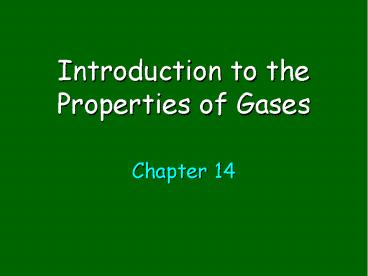Introduction to the Properties of Gases PowerPoint PPT Presentation
Title: Introduction to the Properties of Gases
1
Introduction to the Properties of Gases
- Chapter 14
2
What do you know about gases?
- Particle Diagrams
- Ar(g), H2(g), CO2(g)
- Gases take shape volume of their container
- Gases flow
- Gases have low densities
3
Properties of Gases
- Gases have mass
- Gases take shape volume of container
- Gases are compressible
- Gases easily move through each other (perfume,
skunks!) - Diffusion
- Gases exert pressure
4
Gases take the shape of their container
Why dont the
balloons on
the right keep expanding
until they pop?
5
What is pressure?
- Pressure force per unit area
- P Force
Area
Force mass x acceleration
Would you rather have your foot stepped on by
someone wearing sneakers or stilleto heels?
6
What is air pressure?
- pressure exerted on us by weight of gases above
our heads ( all around our body) - At sea level
- air pressure 1 atmosphere
- this is standard pressure
7
- http//www.youtube.com/watch?vJsoE4F2Pb20
8
Torricelli
- Discovered air pressure
invented mercury
barometer in 1643 - 1st person to propose correct explanation for wind
9
(No Transcript)
10
reporting air pressure - take short-cut
report height of Hg column At 1 atm column
height is 29.92 in Hg or 76 cm Hg or 760 mm Hg
11
How does downward
pressure of Hg in column
compare to pressure
of atmosphere?
12
Can we use H2O in a barometer?
- DHg 13.6 g/ml and Dwater 1.0 g/ml
- Therefore
- A barometer made with water has to be
- 13.6 times taller than a Hg barometer ()
13
How does air pressure at top of Mt. Whitney
(14,494 ft) compare to air pressure at John
Jay?What about Death Valley (86 m below sea
level)?
14
When you drink through straw, you reduce pressure
in straw so
- Why does liquid in cup go up the straw?
- Could you drink a soda
this way on the moon? Why
or why not?
15
Units of pressure 1 atm
- 14.7 lb/in2 U.S. pressure gauges
- 29.9 in Hg U.S. weather
- 101.3 kPa SI Units (Regents)
- (kPa kilopascal)
- 1.013 Bars Physics Astronomy
- 760 Torr or 760 mm Hg CHEMISTRY
16
What causes the pressure of a gas in a closed
container?
impacts of gas molecules with walls of
container anything that increases of impacts
per second or force of each impact increases
pressure
Microscopic View
17
Light molecules move faster and hit walls more
often Heavy molecules hit walls with greater
force These 2 effects essentially balance out
Gas pressure doesnt depend on the identity of
the gas
18
Pressure Depends on
- Concentration ( gas
molecules per unit volume) - and
- 2) temperature
19
How fast do the molecules in the air move?
- Depends on mass
- Light molecules faster than heavy molecules at
same temperature - Temperature measure of average KE of particles
in system
20
Molecular Speeds at 298 K
- H2 1.93 X 105 cm/sec
- He 1.36 X 105 cm/sec
- O2 4.82 X 104 cm/sec
- Ar 4.31 X 104 cm/sec
- Xe 2.38 X 104 cm/sec
48200 cm x 1 in x 1 ft x 1 mile x
3600 sec
sec
2.54 cm
5280 ft
1 hour
1080 miles per hour
21
Speeds of various gasses according to mass
22
Molecular Speed vs. Temperature
23
Pressure Microscopic View
- Gas molecules hit walls of their container
- Pressure depends on
- impacts per unit time
- Force each impact
24
Pressure Macroscopic View
- Pressure depends on
- how many gas molecules per unit volume
- temperature
- same amount of gas exerts different pressure at
different temperatures (tires)
25
Describing Gas Phase System
- Need 4 variables to completely
- describe gas-phase system from
- macroscopic (lab) view
- 1. pressure
- 2. volume
- 3. temperature
- 4. amount gas (moles)
26
Exit Ticket
- Name 5 common properties of all gases
- Draw particle diagram of oxygen in gas phase
- Use your particle diagram to explain at least 2
properties of gases - Bonus At 0oC, a He atom is moving at 1200
meters/sec. How fast is this in miles per hour?
Show all work!

